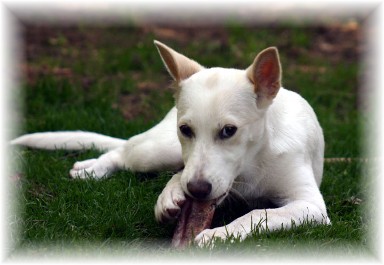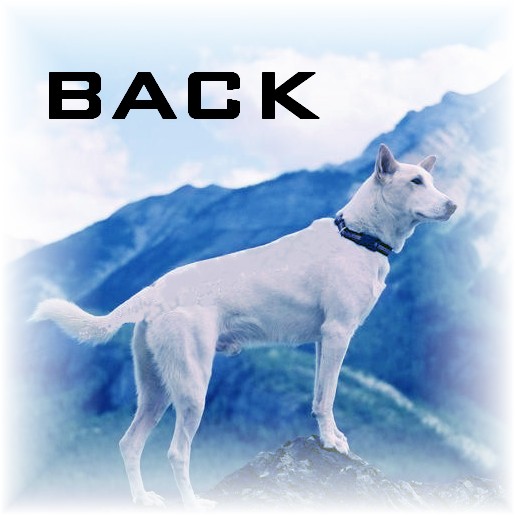| Spring 2007 Newsletter |
| The "Raw Deal" - a look at raw feeding |
 |

|
| Michelle and Larry�s basis was also founded on the Volhard approach. Although more complicated (i.e. more ingredients) than a BARF diet, the concept of a �complete kill� meal made sense. The ingredients are to encompass the complete feeding of a killed animal. They too have since modified the diets of their Canaans according to how they look, feel, and react throughout the seasons. �Macc had demonstrated a habit of licking his rear leg during the winter months. He also resisted eating the raw beef. A section in the Volhard book suggested that he was reluctant with the beef as it was a �cold� meat. We switched him to a �warm� meat, chicken, and he eagerly ate it all. He also stopped licking his leg. We moved back to beef when the warm weather returned.�
Wendy and Victor Sanchez�s initial approach to raw feeding was based on the BARF diet but they also introduced modifications: �Over time we realized that our style of feeding evolved so much over the years that what, and how, we fed our dogs no longer fell in line with the Billinghurst model. After some research we made a more complete transition to the Prey Model approach which more closely resembled the style of feeding that we have graduated to over the years.� Dionna and Robert continue to stick with the diet suggested in Wendy Volhard�s book, but have also made some slight adjustments such as �feeding only one meal, reducing the amount of meat, and adding pumpkin for bulk.� These adjustments were made on the advice of their veterinarian as Tiffy needed to lose significant weight that she had put on taking steroid medication when she was ill. Renee digested several approaches and decided not to follow one specific diet: �Being bogged down in details is overwhelming for me and can certainly intimidate someone new to the diet. I just feed mostly raw meat and bone and throw in extras and veggies when I think of it or when the condition of the dog warrants it.� While being educated on the different approaches, Cathey adopted her own diet based on the concept that �your dog should eat what he/she would have eaten in the dog�s country of origin.�. She believes that one should customize the diet to the dog. Each dog is different and has different dietary needs. Some of her Akitas love fruit cantaloupe, blueberries, bing cherries, and raw eggs, while her Canaan will not touch fruit or raw eggs. However, her Canaan will gobble up the fruit if it is ground up in the meat. �My Canaan Dog can be a very picky eater, and I will often switch her from one food to another, i.e. raw beef to chicken or turkey, more frequently than I switch the Akita�s food.� Benefits of Raw �Softer shiny coats�, �smaller non-smelly stools�, and �clean white teeth� are the top three observations that these Canaan Dog owners notice when they implement a natural diet. Since the stools are generally much harder and more compact on a raw diet, anal gland secretion is also more effective. For many, the introduction of chicken necks and backs helps polish up teeth nicely, and picking up less poop is always a welcome reward! �Enhanced energy levels�, �improved muscle tone�, and an �overall solidness of the dog� are other notable improvements that these owners proudly admit. Michelle and Larry need their Canaans to be in top shape for herding lessons, trials, and events so overall conditioning is very important: �herding requires a well-conditioned dog to perform outruns and cover great distances in the pastures.� They maintain that the raw approach aids in stamina and overall performance � and the proof is always in the pudding! Owners also comment on the �reduced vet visits�, �minimal shedding�, �decrease in water consumption�, and the �eagerness of the dog to eat their food�. Cathey says she witnesses her dogs having � a contentment when finished eating.� Chris loves the fact that her dogs have �better smelling breath, larger litter size and larger puppy birth weight and just an overall better wellbeing.� Wendy and Victor are enjoying the advantages of �increased strength of immunity, and vigorous puppies.� The Importance of Supplements For these Canaan owners the �complete� diet consists of various supplements added to the meat. Foods rich in Omega-3, which include flaxseed oil, safflower oil, salmon and other cold water fishes help maintain healthy coats, appropriate weight, and keep fluid in the joints. For digestive purposes, Michelle and Larry add apple cider vinegar and yoghurt to the meat. Vitamin B, C, and E in powder or capsule form along with Alfalfa and sea salts offer many minerals and essential vitamins. Cathey gives her dogs a tablespoon of cod liver oil, or a Thorne Super EPA (essential 1 2 3 4 |
 |
| "Mackenzie" Photo courtesy of Wendy Sanchez |
